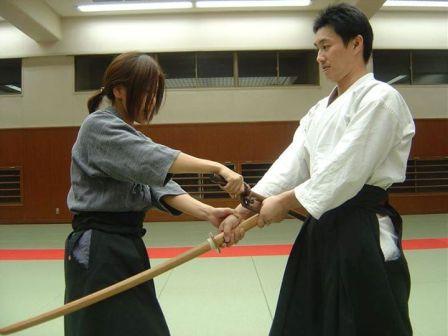Ikkaku
One of the arts studied and trained within Masaki-ryu Nakajima-ha Kusari is Edo Machikata Juttejutsu.
This art has been
transmitted from the Edo period and was taught to the Feudal Edo police force. Arresting tactics
for opponents who are
unarmed or armed with bladed weapons, long weapons, and even chains form the bulk of
this art.
Broadly speaking, the art can be divided into "Ikkaku no Kata" (forms focusing on the application of a single jutte
(hooked
iron truncheon) to evade and restrain an opponent who is unarmed or armed with a sword and then bind him
with a hojo (arresting
cord), and "Sokaku no Kata" (forms focusing on the application of a jutte (hooked iron truncheon)
and naeshi (iron truncheon)
to
evade and restrain an opponent who is armed with a sword, long weapon or chain, and
then bind him with a
hojo (arresting cord).
Interestingly, Edo Machikata Juttejutsu is one of the only arts that still teaches how to restrain an opponent with the
jutte,
and
then bind him with the hojo as a single form. We also train in the effective use of hayanawa (quick ties
used to
immediately
arrest an opponent), kaginawa (a hooked cord also used in arresting), and hon-nawa (more
formal ties used to present crimal
suspects to court magistrates).
江戸町方十手術が正木流中島派鎖十手術で稽古・鍛錬する武術の一つです。江戸時代の捕物武術で、素手、刃物、
長物や鎖武器
などに対する対処法が伝わっています。
大別すると、《一角の型》という素手や刀を持った相手を十手一丁で避け、取り押さえて施縄する型と、《双角の型》
という刀や長物、鎖武器などをもった相手同じく十手とナエシで取り押さえ、施縄する型とありますが、各型に相手の
攻撃を避け、十手と体術(体の運用)で相手を取り押さえ、そのまま早縄を掛ける方法を伝授します。現代ではこのように
十手術と捕縄術が完全な形で稽古されている武術がさほどないようです。
他にも鉤縄の遣い方や本縄なども伝わっていま す。


